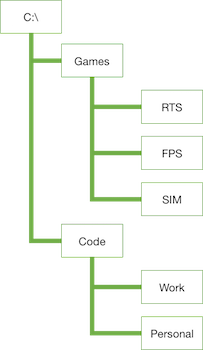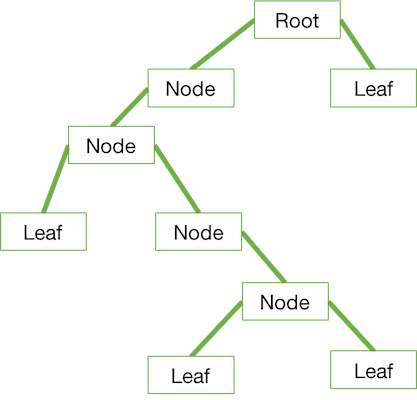This post is one in a series about stuff formally trained programmers know – the rest of the series can be found here.
#Trees This post will look at the mighty tree, which is more a pattern than a specific data structure. The reason to understand the pattern is that so many of the data structures we will look at in the future use it that a good understanding of it provides a strong basis to work from.
As a computer user though, you already have seen and used a tree structure - you may have just not known it. The most common form of it is the file system, where you have a root (i.e. / or C:\) and that has various folders under it. Each folder itself can have folders, until you end at an empty folder or a file.

This is the way a tree structure works too: you start with a root, then move to nodes and finally end with leaves.

In the basic concept of a tree there are no rules on the nodes and the values they contain, so a node may contain zero, one, two, three or a hundred other nodes.
What makes a tree really powerful, is that it really is a collection of trees. i.e. if you take any node it is in itself a tree and so the algorithms used to work with a tree work with each node too. This enables you to work with a powerful computer science concept, recursion.
#Recursion
Recursion is a concept that lacks a real world equivalent and so can be difficult to grasp initially. At its simplest for these posts, it is a method or function which calls itself, until instructed to stop. For example, you might write a function called getFiles which takes in a path to a folder and returns an array of filenames. Inside getFiles it loops over all the files in the folder and adds them to a variable to return. Then it loops over all the folders in that folder and for each folder it finds, it calls getFiles again.
function getFiles(path){
var result = [];
fs.readdirSync(path).each(file => result.push(file)); // get all files using Node, and push them to the result array.
var directories = fs.getDirectoriesSync(path); // not real node call - for example.
directories.each(directory =>{
var files = getFiles(directory); // calling itself.
files.each(file => result.push(file));
});
return result;
}
function IEnumerable<string> GetAllFiles(string path) // changed to GetAllFiles so it doesn't get too confusing with the built in GetFiles
{
var result = new List<string>();
result.AddRange(Directory.GetFiles(path));
foreach (var directory in Directory.GetDirectories(path))
{
result.AddRange(GetAllFiles(directory)); // recursively calling itself
}
return result;
}
#Implementations It doesn’t make sense to talk about coding implementations at this point since this is more a pattern than a structure and we would need a lot more information on what we want to achieve to do actually go through a code implementation. That said, it is interesting to see where trees are used:
- File systems
- Document Object Models (like HTML or XML)
#References
